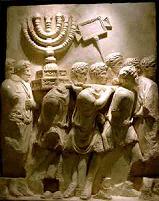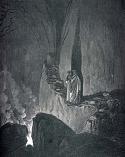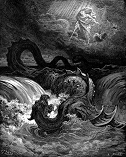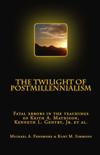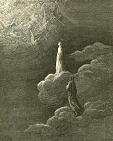Moses Stuart
(1836)
Miscellaneous comments from a great Preterist commentator
(On Luke 21:24 ;Rev. 11:1)
"In Rev. 11:2, the time during which the Romans are to tread down the holy city, (in this case the capital is, as usual in the Jewish Scripture, the representation of the country), is said to be forty-two months = three and a half years. The active invasion of Judea continued almost exactly this length of time, being at the most only a few days more; so few that they need not, and would not, enter into symbolic computation of time." (Stuart, p. 279)"Forty and two months. After all the investigation which I have been able to make I feel compelled to believe that the writer refers to a literal and definite period, although not so exact that a singly day, or even a few days, or variation from it would interfere with the object he has in view. It is certain that the invasion of the Romans lasted just about the length of the period named, until Jerusalem was taken. And although the city was not besieged so long, yet the metropolis in this case, as in innumerable others in both Testaments, appears to stand for the country of Judea. During the invasion of Judea by the Romans the faithful testimony of the persecuted witnesses for Christianity is continued, while at last they are slain. The patience of God in deferring so long the destruction of the persecutors is displayed by this, and especially His mercy in continuing to warn and reprove them. This is a natural, simple, and easy method of interpretation, to say the least, and one which, although it is not difficult to raise objections against it, I feel constrained to adopt."
(On Hebrews 9:26)
"But now, at the close of the [Jewish] dispensation, He has once for all made His appearance."(On Hebrews 10:37)
"The Messiah will speedily come, and, by destroying the Jewish power, put an end to the suffering which your persecutors inflict upon you." (Commentary on Hebrews, in loc.)(On Hebrews 12:25-29, and the New Heavens and Earth)
"That the passage has respect to the changes which would be introduced by the coming of the Messiah, and the new dispensation which he would commence, is evident from Haggai ii. 7-9. Such figurative language is frequent in the Scriptures, and denotes great changes which are to take place. So the apostle explains it here, in the very next verse. (Comp. Isa. 13:13; Haggai 2:21,22; Joel 3:16; Matt. 24:29-37). (Hebrews, in loc.)(On the Early Date of Revelation)
"If now the number of the witnesses were the only thing which should control our judgment in relation to the question proposed, we must, so far as external evidence is concerned, yield the palm to those who fix upon the time of Domitian. But a careful examination of this matter shows, that the whole concatenation of witnesses in favour of this position hangs upon the testimony of Irenaeus, and their evidence is little more than a mere repetition of what he has said. Eusebius and Jerome most plainly depend on him; and others seem to have had in view his authority, or else that of Eusebius." (Ibid. 2:269..)"I say this, with full recognition of the weight and value of Irenaeus’s testimony, as to any matters of fact with which he was acquainted, or as to the common tradition of the churches. But in view of what Origen has said. . . , how can we well suppose, that the opinion of Irenaeus, as recorded in Cont. Haeres, V. 30 was formed in any other way, than by his own interpretation of Rev. 1:9. (1:281)
"If there be anything certain in the principles of hermeneutics, it is certain that they decide in favour of a reference to Judea and its capital in Rev. vi – xi. The very fact, moreover, that the destruction of Jerusalem (chap. xi) is depicted in such outlines and mere sketches, shows that it was then sure, when the book was written. It is out of all question, except by mere violence, to give a different interpretation to this part of the Apocalypse." (1:276)
"Here then, on the very front of the book, is exhibited a title-page, as it were, indicative of a conspicuous part of the contents of the work. The punishment of the unbelieving and persecuting Jew must follow the coming of the Lord; and this it is one leading object of the book to illustrate and confirm. If so, then the prediction must have preceded the event predicted.’ (1:273)
”A majority of the older critics have been inclined to adopt the opinion of Irenaeus, viz., that it was written during the reign of Domitian, i.e., during the last part of the first century, or in A.D.95 or 96. Most of the recent commentators and critics have called this opinion in question, and placed the composition of the book at an earlier period, viz., before the destruction of Jerusalem.” (A Commentary on the Apocalypse, 2 vols; Andover, MD: Allen, Morrill, and Wardwell, 1845; p. 1:263)
“The manner of the declaration here seems to decide, beyond all reasonable appeal, against a later period than about A.D.67 or 68, for the composition of the Apocalypse.” (A Commentary on the Apocalypse, 2 vols; Andover, MD: Allen, Morrill, and Wardwell, 1845; p. 2:326)
(On the timing of John's Banishment)
"Now it strikes me, that Tertullian plainly means to class Peter, Paul, and John together, as having suffered at nearly the same time and under the same emperor. I concede that this is not a construction absolutely necessary; but I submit it to the candid, whether it is not the most probable." (1 :284n.)(On Nero, 'The Beast')
"The idea that Nero was the man of sin mentioned by Paul, and the Antichrist spoken of so often in the epistles of St. John, prevailed extensively and for a long time in the early church..""Augustine says: What means the declaration, that the mystery of iniquity already works?... Some suppose this to be spoken of the Roman emperor, and therefore Paul did not speak in plain words, because he would not incur the charge of calumny for having spoken evil of the Roman emperor: although he always expected that what he had said would be understood as applying to Nero." (Excurs. iii.)
(On Revelation 1:7)
"Here then, on the very front of the book, is exhibited a title-page, as it were, indicative of a conspicuous part of the contents of the work. The punishment of the unbelieving and persecuting Jew must follow the coming of the Lord; and this it is one leading object of the book to illustrate and confirm. If so, then the prediction must have preceded the event predicted.’ (1:273)(On Revelation 13:5-7)
"The persecution of Nero began about the middle or latter part of Nov. A.D. 64, at Rome. It ended with the death of Nero, which was on the ninth of June, A.D. 68, for on that day Galba entered Rome and was proclaimed emperor. Here again is 3 + years or 1260 days with sufficient exactness; for the precise time of forty-two months expires about the middle or end of May, and Nero died in the first part of June. . . (2:469)"After all the investigation which I have been able to make, I feel compelled to believe that the writer refers to a literal and definite period, although not so exact that a single day, or even a few days, of variation from it would interfere with the object he has in view. It is certain that the invasion of the Romans lasted just about the length of the period named, until Jerusalem was taken. " (2:218)
(On Revelation 17:10)
"It seems indisputably clear that the book of Revelation must be dated in the reign of Nero Caesar, and consequently before his death in June, A.D. 68. He is the sixth king; the short-lived rule of the seventh king (Galba) "has not yet come." (2:324)"But why only seven kings? First because the number seven is the reigning symbolic number of the book; then, secondly, because this covers the ground which the writer means specially to occupy, viz., it goes down to the period when the persecution then raging would cease. (2:325,326)
(On Origins of Praeterist View)
"Near the commencement of the seventeenth century (1614), the Spanish Jesuit Ludovicus ab Alcasar published his Vestigatio arcani Sensus in Apocalypsi, a performance distinguished by one remarkable feature, which was then new. He declared the Apocalypse to be a continous and connected work, making regular advancement from beginning to end, as parts of one general plan in the mind of the writer. In conformity with this he brought out a result which has been of great importance to succeeding commentators. Rev. v-vi, he thinks, applies to the Jewish enemies of the Christian Church; xi-xix to heathen Rome and carnal and worldly powers, xx-xxii to the final conquests to be made by the church, and also to its rest, and its ultimate glorification. This view of the contents of the book had been merely hinted at before, by Hentenius, in the Preface to his Latin version of Arethas, Par. 1547. 8vo; and by Salmeron in his Preludia in Apoc. But no one had ever developed this idea fully, and endeavoured to illustrate and enforce it, in such a way as Alcasar ... Although he puts the time of composing the Apocalypse down to the exile of John under Domitian, yet he still applies ch. v-xi to the Jews, and of course regards the book as partly embracing the past."It might be expected, that a commentary that thus freed the Romish church from the assaults of the Protestants, would be popular among the advocates of the papacy. Alcasar met, of course, with general approbation and reception among the Romish community. "'(Stuart, Moses, "Commentary on the Apocalypse", Allen, Morrill and Wardell, Andover, 1845, Volume 1, p. 464.)
To receive Kurt Simmons’ e-mail newsletter, The Sword & The Plow, click the Subscribe link:
All rights reserved.
